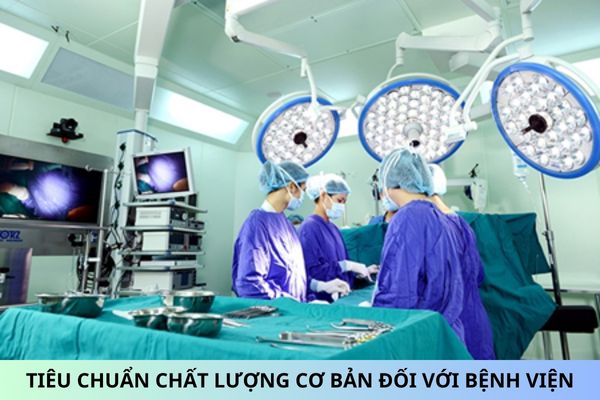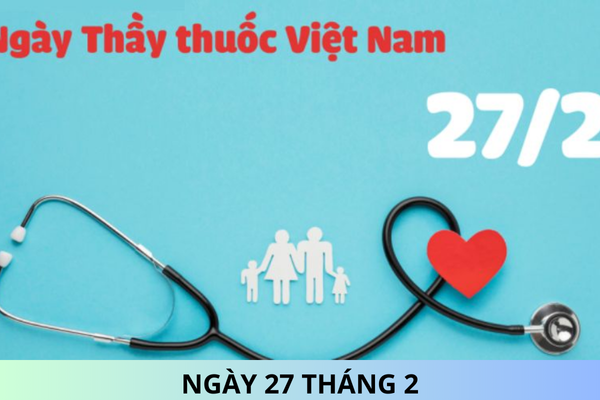What are basic quality standards for hospitals in Vietnam from January 1, 2025?
What are basic quality standards for hospitals in Vietnam from January 1, 2025?
On November 16, 2024, the Minister of Health of Vietnam issued Circular 35/2024/TT-BYT stipulating the basic quality standards for hospitals, including:
- Standards for facilities
- Standards for scale and organizational structure
- Standards for personnel
- Standards for medical equipment
- Standards for professional practice
These basic quality standards apply only to medical examination and treatment facilities that have been licensed to operate in the form of hospitals.
Based on the Appendix issued together with Circular 35/2024/TT-BYT, the basic quality standards for hospitals are specified as follows:
Paraclinical departments: must have at least one laboratory and one imaging diagnosis room.
|
No. |
STANDARD |
ASSESSMENT RESULT |
ASSESSMENT RESULT |
|
I. |
Standards for facilities |
|
|
|
1. |
The hospital must have a fixed location.* |
|
|
|
2. |
The hospital must have access for ambulances to enter the emergency area.* |
|
|
|
3. |
Departments, rooms, specialized divisions: |
|
|
|
3.1. |
Arranged appropriately with the function of each part* |
|
|
|
3.2. |
Ensure convenient transportation infrastructure connection between specialized divisions for examination, treatment, and safety for patients, their families, and medical staff.* |
|
|
|
4. |
There are signs, diagrams, and directional signs to departments, rooms, specialized and administrative divisions.* |
|
|
|
5. |
There are emergency transport vehicles inside and outside the hospital.* |
|
|
|
6. |
Standards for the environment: |
|
|
|
6.1. |
Have measures for handling household waste. |
|
|
|
6.2. |
Have measures for handling medical waste. |
|
|
|
7. |
Standards for radiation safety: |
|
|
|
7.1. |
Have a license for radiation-related activities. |
|
|
|
7.2. |
Have a document assigning responsibility for radiation safety work. |
|
|
|
7.3. |
Radiation workers have a radiation worker certificate. |
|
|
|
7.4. |
Equipped with dosimeters for radiation workers. |
|
|
|
8. |
Have electricity and water to serve the activities of the medical examination and treatment facility. |
|
|
|
II. |
Standards for scale and organizational structure |
|
|
|
1. |
The hospital must have an organizational structure including departments: medical examination, clinical, paraclinical, pharmacy, and auxiliary parts. |
|
|
|
2. |
The medical examination department must have a reception area, emergency rooms, holding rooms, consultation rooms, and rooms for performing techniques and procedures (if performing techniques and procedures). |
|
|
|
3. |
Clinical departments: |
|
|
|
4. |
Paraclinical departments must have at least one laboratory and one imaging diagnosis room. |
|
|
|
5. |
The pharmacy department has divisions: pharmaceutical operations, warehouse and dispensing, pharmaceutical statistics, drug information, and clinical pharmacy. |
|
|
|
6. |
Nutrition department; clinical nutrition division; person in charge of nutritional work; person working in nutrition. |
|
|
|
7. |
Infection control department; infection control division; person working in infection control. |
|
|
|
8. |
Other specialized divisions in the hospital appropriate for the scope of professional activities. |
|
|
|
9. |
Rooms and divisions to perform functions of comprehensive planning, human resource organization, quality management, nursing, finance-accounting, information technology, medical equipment, and other necessary functions. |
|
|
|
III. |
Standards for personnel |
|
|
|
1. |
Practitioners are assigned work appropriate to the scope of practice approved by competent authorities. |
|
|
|
2. |
Practitioners are regularly updated on medical knowledge. |
|
|
|
IV. |
Standards for medical equipment |
|
|
|
1. |
Medical equipment to perform techniques within the scope of professional activities approved by competent authorities, with management records for such equipment. |
|
|
|
2. |
Regulations on management, use, inspection, maintenance, repair, replacement of parts, and preservation of medical equipment at medical examination and treatment facilities. |
|
|
|
3. |
Procedures for using, operating, repairing, maintaining, ensuring the quality of medical equipment. |
|
|
|
4. |
Medical equipment subject to verification, calibration is verified, calibrated according to regulations. |
|
|
|
5. |
Division and personnel implementing management tasks in using, inspecting, maintaining, repairing, verifying, calibrating medical equipment. |
|
|
|
V. |
Standards for professional practice |
|
|
|
1. |
Inpatient treatment, organizing specialized duty service 24/7. |
|
|
|
2. |
Outpatient examination and treatment procedures. |
|
|
|
3. |
Popularization, application, and development of professional procedures for examination and treatment: |
|
|
|
3.1. |
Popularize examination and treatment technical procedures issued by the Ministry of Health or hospitals. |
|
|
|
3.2. |
Popularize diagnostic and treatment guidelines issued by the Ministry of Health or hospitals. |
|
|
|
3.3. |
Apply examination and treatment technical procedures issued by the Ministry of Health or hospitals. |
|
|
|
3.4. |
Apply diagnostic and treatment guidelines issued by the Ministry of Health or hospitals. |
|
|
|
3.5. |
Train or popularize or guide adherence to prescription regulations. |
|
|
|
4. |
Quality management: |
|
|
|
4.1. |
Establish a quality management system. |
|
|
|
4.2. |
Operating regulations of the hospital quality management board. |
|
|
|
4.3. |
Quality improvement plan/project for the entire hospital for the current year or for the period from one to three years. |
|
|
|
4.4. |
Hospital quality indicators and measurement results. |
|
|
|
4.5. |
Laboratory quality management includes laboratory quality management plan, process guidance development, training for related staff, evaluation of laboratory quality management plan implementation. |
|
|
|
4.6. |
Reporting medical incidents. |
|
|
|
5. |
Infection control includes organization, task assignment; process development. |
|
|
Note: For standards marked with *, only provide proof documents again when there is a change between two evaluations.

What are basic quality standards for hospitals in Vietnam from January 1, 2025? (Image from Internet)
What are organizational forms of medical examination and treatment facilities in vietnam?
Based on Article 48 of the Law on Medical Examination and Treatment 2023, the organizational forms of medical examination and treatment facilities include:
- Hospital
- Military medical post
- Maternity home
- Clinic
- Traditional medicine treatment room
- Paraclinical service facility
- Health station
- Outpatient emergency facility
- Family medicine medical examination and treatment facility
- Other organizational forms of medical examination and treatment facilities as prescribed by the Government of Vietnam
Which agency is responsible for evaluating and reporting basic quality standards for hospitals in Vietnam?
Based on Article 2 of Circular 35/2024/TT-BYT, the organization of implementation is stipulated:
Article 2. Organization of Implementation
- The Department of Medical Examination and Treatment Management is responsible for:
a) Serving as the focal point for directing, organizing the implementation of this Circular, and guiding the assessment, professional content according to assigned functions and duties;
b) Monitoring, urging medical examination and treatment facilities under its management to assess basic quality standards for hospitals as prescribed by this Circular.
- The Department of Traditional Medicine and Pharmacy Management is responsible for directing, guiding, inspecting, and urging the implementation of this Circular according to assigned functions and duties.
- The Department of Health of provinces and centrally-run cities is responsible for:
a) Directing, guiding, inspecting, and urging the implementation of this Circular for medical examination and treatment facilities under its management;
b) Monitoring, urging medical examination and treatment facilities under its management to assess basic quality standards for hospitals as prescribed by this Circular.
- Medical examination and treatment facilities are responsible for:
a) Implementing this Circular;
b) Reviewing, adding, and overcoming to ensure maintaining the quality of medical examination and treatment at a basic level;
c) Conducting evaluation and reporting the evaluation results according to regulations.
According to the above regulations, hospitals (medical examination and treatment facilities) are responsible for conducting evaluation and reporting the evaluation results of basic quality standards for hospitals.










